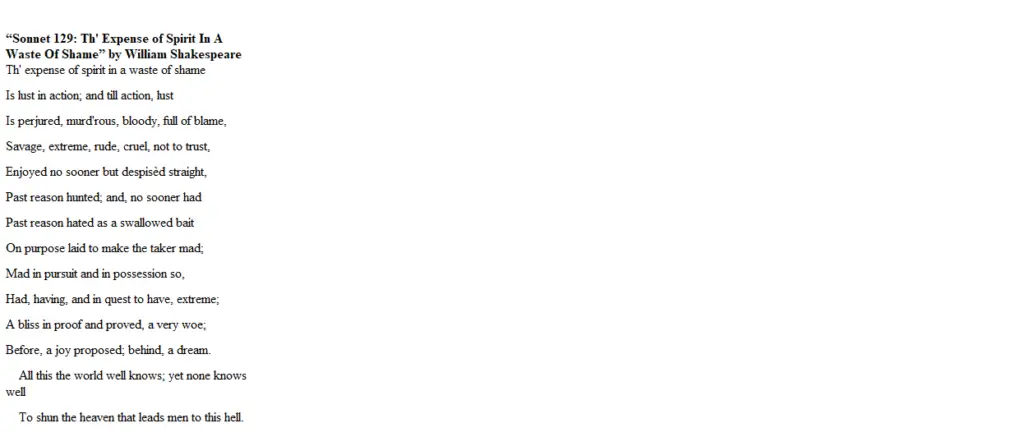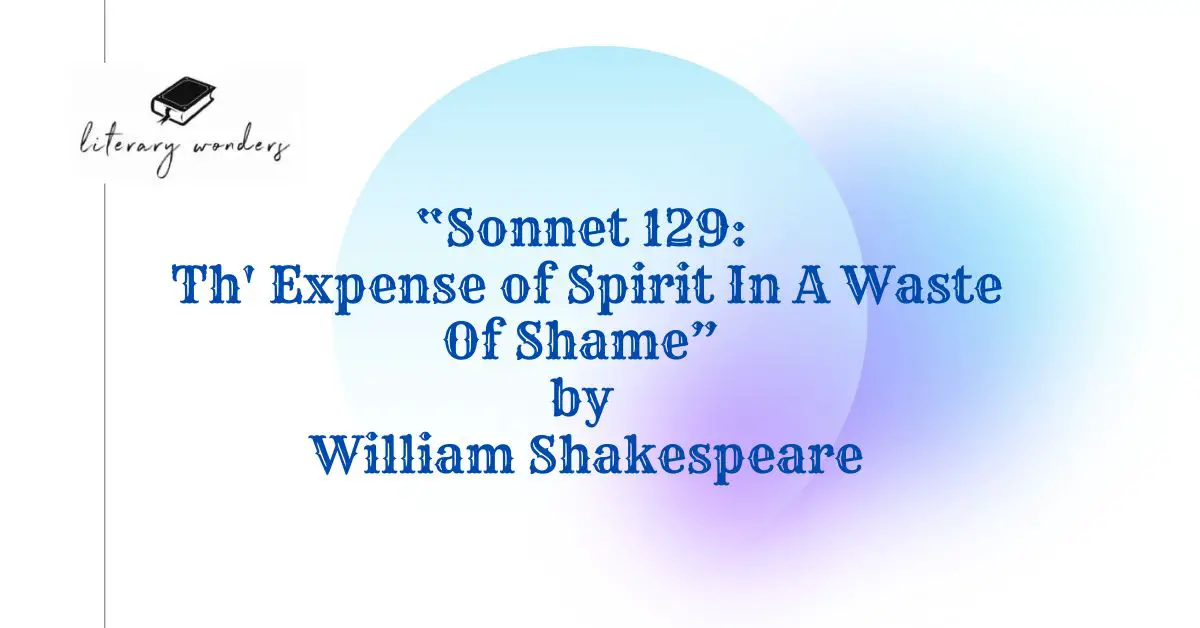
Summary of the Poem, “Sonnet 129“
- Popularity of “Sonnet 129”: “Sonnet 29” is a love poem by one of literature’s most illustrious authors and poets. Shakespeare considered the strength of lust when he penned this poem, both physically and emotionally. He also discusses sex, biological functions, and the emotions involved in romantic relationships. The poem achieved unprecedented recognition due to its honest portrayal of romantic feelings.
- As a Representative of Lust in “Sonnet 129,”: This poem explores the horrible things that lust drives people to commit. The speaker starts it off by explaining how engaging in sexual activity costs one’s spirit. However, those who carry out such deeds feel ashamed and lose their enduring strength. The speaker discusses the drawbacks of passion as the poem progresses. To him, cruelty is the result of a violent emotion. The speaker skillfully captures the seductive essence of love in the second quatrain, which numbs individuals by offering improbable fantasies of bliss and pleasure. However, people hurt their inner selves when consumed by these stupid notions. The poem’s speaker declares that every man is led by lust, even if he is aware that it will cause him to stray from the path of righteousness.
- Major Themes in “Sonnet 129”: The poem’s main themes include confession, lust, loss, and emotions. The poem focuses primarily on lust and desire as themes. In the poem’s start, the speaker considers how lust may be harmful and can cause shame and self-degradation. When the speaker talks about his own battles with lust and his feelings of shame and guilt, the poem also offers the speaker’s viewpoint. He considers lust and its ramifications throughout the poem, calling it a “foul” and “bestial” emotion that can result in self-destructive behavior. The speaker’s advice to reject lust and seek out a more moral course in the last couplet provides the poem’s conclusion. Consequently, the poem offers a complex understanding of lust and desire that eventually rejects it as a destructive force yet admits its strength and alluring qualities.
Analysis of Literary Devices Used in “Sonnet 129”
Shakespeare used a few literary techniques in the poem to increase its intended impact. The following is an analysis of the poetic devices used.
- Assonance: Assonance is the repeating of vowel sounds inside the same line, such as the vowel sound of “Th’ expense of spirit in a waste of shame” and the vowel sound of “Past reason hunted; and, no sooner had.”
- Alliteration: The word “alliteration” refers to the swift succession of consonant sounds that are repeated inside the same line, such as the sound of “t” in the phrase “to make the taker mad.”
- Consonance: Consonance is the repeating of consonant sounds inside a single line, such as the sound of “All this the world well knows; yet none knows well” and “Before, a joy proposed; behind, a dream” in the above examples.
- Enjambment: Enjambment is characterized as verse-based thinking that continues onto the next line after a line break. For instance;
“Past reason hunted; and, no sooner had
Past reason hated as a swallowed bait
On purpose laid to make the taker mad;”
- Imagery: Using imagery, authors can influence how readers experience things using all five senses. Shakespeare utilised phrases like “Before, a joy proposed; behind, a dream,” “On purpose laid to make the taker mad,” and “Savage, extreme, rude, cruel, not to trust” to evoke certain images in this poem.
- Irony: Irony is a figure of speech where words are employed in a way that changes their intended meaning from what the words actually mean. In the poem’s final words, the poet used this approach to express his sympathy for humanity by highlighting the frailty of human nature;
“All this the world well knows; yet none knows well
To shun the heaven that leads men to this hell.”
- Metaphor: This figure of speech implies a comparison between two things that are fundamentally unrelated. To demonstrate the strength and damaging effects of lust on people, the poet utilised it as an extended metaphor.
- Symbolism: Symbolism is the use of symbols to represent concepts and traits by giving them meanings that are symbolic rather than literal. The poem uses images of love, lust, intimacy, and shame as symbols.
The analysis demonstrates that the poet was able to talk persuasively on the force of lust thanks to these tactics.
Analysis of Poetic Devices Used in “Sonnet 129”
- Diction: It refers to the language’s style. The poem uses simple, beautiful, and descriptive language.
- End Rhyme: The stanza is made melodic by using an end rhyme. In this sonnet, Shakespeare uses rhymes at the ends, such as “shame/blame,” “had/mad,” and “so/woe.”
- Iambic pentameter: Iambic pentameter, which has five iambs per line, is a third type of meter that certain poems use. An example is “Th’ expense of spirit in a waste of shame.”
- Rhyme structure: The rhyme system used in the poem is ABAB CDCD EFEF GG.
- Tone: It refers to the text’s voice. The poem starts with a somber tone before becoming combative.
FAQs about the Poem “Sonnet 129: Th’ Expense of Spirit In A Waste Of Shame” by William Shakespeare
- What is the summary of “Sonnet 129: Th’ Expense of Spirit In A Waste Of Shame”?
Shakespeare’s “Sonnet 129” tackles the pernicious nature of lust and its effects on both the physical and emotional elements of people. The speaker talks about how having sex makes one lose their inner fortitude and enduring traits, which causes shame and degradation. The poem explores lust, confession, grief, and emotions before advising against it in favour of a more moral course of action.
- Why is “Sonnet 129” popular?
The popularity of “Sonnet 129” can be attributed to its open discussion of the power and effects of passion. Readers are moved by Shakespeare’s deft examination of the physical, emotional, and psychological components of romantic relationships and sexual urges. The poem’s ongoing popularity is a result of its straightforward portrayal of human nature and its unfiltered emotions.
- How does “Sonnet 129” represent lust?
The poem represents lust by exploring the harmful and destructive actions that it leads individuals to. The speaker emphasizes how giving in to lusty desires saps a person’s inner spirit and power and causes them to feel ashamed and degraded. The poem emphasizes how lust can deviate from moral lines and be seductive while also being detrimental.
- What are the major themes of “Sonnet 129”?
Confession, lust, loss, and emotions are among “Sonnet 129″‘s key topics. The poem examines the negative effects of giving in to such cravings, with lust and want serving as major topics. The poem also examines the speaker’s internal conflicts with lust, remorse, and humiliation.
- How does the poem use metaphor and symbolism?
The poem uses elaborate metaphors to show lust’s power and negative consequences. It uses symbols that represent love, lust, intimacy, and shame. For instance, the heaven-hell dichotomy is figuratively used to represent lust as a destructive force that pulls people away from moral paths.
- What is the structure of the poem’s rhyme and meter?
Iambic pentameter, a metrical form with five iambs in each line, is used in the poem’s writing. The ABAB CDCD EFEF GG rhyme scheme produces a structured and melodious rhythm that adds to the poem’s charm.
- How does the tone of the poem change?
The poem’s opening is solemn as it presents the concept of lust’s negative effects. The poem’s tone intensifies as it goes along, criticizing the nature of lust and its effects. The speaker’s change in voice symbolizes the theme’s continual development.
Suggested Readings

